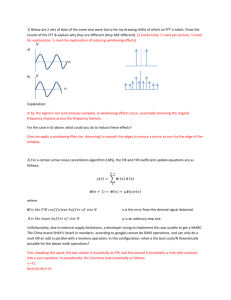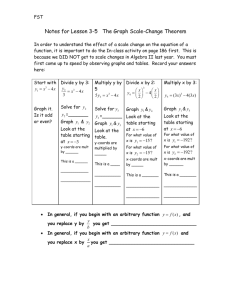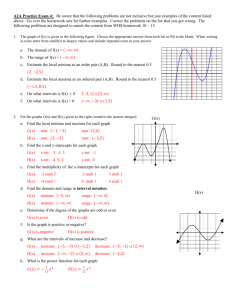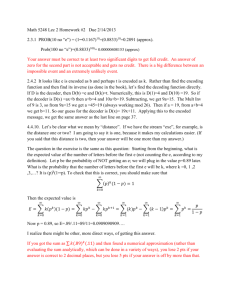Lecture_2_Recursion
advertisement
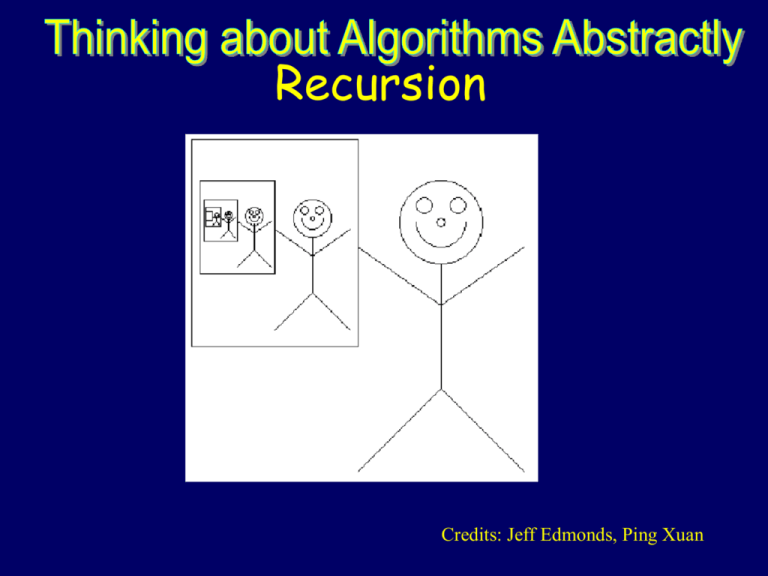
Recursion
Credits: Jeff Edmonds, Ping Xuan
Code
Representation of an Algorithm
MULT(X,Y):
If |X| = |Y| = 1 then RETURN XY
Break X into a;b and Y into c;d
e = MULT(a,c) and f =MULT(b,d)
RETURN
e 10n + (MULT(a+b, c+d) – e - f) 10n/2 + f
Tree of Frames
MULT(X,Y):
If |X| = |Y| = 1 then RETURN XY
Break X into a;b and Y into c;d
e = MULT(a,c) and f =MULT(b,d)
RETURN
e 10n + (MULT(a+b, c+d) – e - f) 10n/2 + f
X = 21
Y = 23
ac = 4
bd = 3
(a+b)(c+d) = 15
XY = 483
X=2
Y=2
XY=4
X=1
Y=3
XY=3
X=3
Y=5
XY=15
X = 2133
Y = 2312
ac = 483
bd = 396
(a+b)(c+d) = 1890
XY = 4931496
X = 33
Y = 12
ac = 3
bd = 6
(a+b)(c+d) = 18
XY = 396
X=3
Y=1
XY=3
X=3
Y=2
XY=6
X = 54
Y = 35
ac = 15
bd = 20
(a+b)(c+d) = 72
XY = 1890
X=6
Y=3
XY=18
X=5
Y=3
XY=15
X=4
Y=5
XY=20
X=9
Y=8
XY=72
Friends
MULT(X,Y):
If |X| = |Y| = 1 then RETURN XY
Break X into a;b and Y into c;d
e = MULT(a,c) and f =MULT(b,d)
RETURN
e 10n + (MULT(a+b, c+d) – e - f) 10n/2 + f
X = 21
Y = 23
ac = 4
bd = 3
(a+b)(c+d) = 15
XY = 483
X=2
Y=2
XY=4
X=1
Y=3
XY=3
X=3
Y=5
XY=15
X = 2133
Y = 2312
ac = 483
bd = 396
(a+b)(c+d) = 1890
XY = 4931496
X = 33
Y = 12
ac = 3
bd = 6
(a+b)(c+d) = 18
XY = 396
X=3
Y=1
XY=3
X=3
Y=2
XY=6
One Friend for each
stack frame.
Each worries only
about his job.
X = 54
Y = 35
ac = 15
bd = 20
(a+b)(c+d) = 72
XY = 1890
X=6
Y=3
XY=18
X=5
Y=3
XY=15
X=4
Y=5
XY=20
X=9
Y=8
XY=72
Friends
MULT(X,Y):
If |X| = |Y| = 1 then RETURN XY
Break X into a;b and Y into c;d
e = MULT(a,c) and f =MULT(b,d)
RETURN
e 10n + (MULT(a+b, c+d) – e - f) 10n/2 + f
X = 21
Y = 23
ac = 4
bd = 3
(a+b)(c+d) = 15
XY = 483
X=2
Y=2
XY=4
X=1
Y=3
XY=3
X=3
Y=5
XY=15
X = 2133
Y = 2312
ac = 483
bd = 396
(a+b)(c+d) = 1890
XY = 4931496
X = 33
Y = 12
ac = 3
bd = 6
(a+b)(c+d) = 18
XY = 396
X=3
Y=1
XY=3
X=3
Y=2
XY=6
Worry about one
step at a time.
Imagine that you
are one specific
friend.
X = 54
Y = 35
ac = 15
bd = 20
(a+b)(c+d) = 72
XY = 1890
X=6
Y=3
XY=18
X=5
Y=3
XY=15
X=4
Y=5
XY=20
X=9
Y=8
XY=72
Friends
MULT(X,Y):
If |X| = |Y| = 1 then RETURN XY
Break X into a;b and Y into c;d
e = MULT(a,c) and f =MULT(b,d)
RETURN
e 10n + (MULT(a+b, c+d) – e - f) 10n/2 + f
X = 33
Y = 12
ac =
bd =
(a+b)(c+d) =
XY =
•Consider your input instance
Friends
MULT(X,Y):
If |X| = |Y| = 1 then RETURN XY
Break X into a;b and Y into c;d
e = MULT(a,c) and f =MULT(b,d)
RETURN
e 10n + (MULT(a+b, c+d) – e - f) 10n/2 + f
X = 33
Y = 12
ac = ?
bd = ?
(a+b)(c+d) =
XY =
X=3
Y=1
XY=?
X=3
Y=2
XY=?
X=6
Y=3
XY=?
•Consider your input instance
•Allocate work
•Construct one or more
subinstances
Friends
MULT(X,Y):
If |X| = |Y| = 1 then RETURN XY
Break X into a;b and Y into c;d
e = MULT(a,c) and f =MULT(b,d)
RETURN
e 10n + (MULT(a+b, c+d) – e - f) 10n/2 + f
X = 33
Y = 12
ac = 3
bd = 6
(a+b)(c+d) = 18
XY =
X=3
Y=1
XY=3
X=3
Y=2
XY=6
X=6
Y=3
XY=18
•Consider your input instance
•Allocate work
•Construct one or more
subinstances
•Assume by magic your friends
give you the answer for these.
Friends
MULT(X,Y):
If |X| = |Y| = 1 then RETURN XY
Break X into a;b and Y into c;d
e = MULT(a,c) and f =MULT(b,d)
RETURN
e 10n + (MULT(a+b, c+d) – e - f) 10n/2 + f
X = 33
Y = 12
ac = 3
bd = 6
(a+b)(c+d) = 18
XY = 396
X=3
Y=1
XY=3
X=3
Y=2
XY=6
X=6
Y=3
XY=18
•Consider your input instance
•Allocate work
•Construct one or more
subinstances
•Assume by magic your friends
give you the answer for these.
•Use this help to solve your own
instance.
Friends
MULT(X,Y):
If |X| = |Y| = 1 then RETURN XY
Break X into a;b and Y into c;d
e = MULT(a,c) and f =MULT(b,d)
RETURN
e 10n + (MULT(a+b, c+d) – e - f) 10n/2 + f
X = 33
Y = 12
ac = 3
bd = 6
(a+b)(c+d) = 18
XY = 396
X=3
Y=1
XY=3
X=3
Y=2
XY=6
X=6
Y=3
XY=18
•Consider your input instance
•Allocate work
•Construct one or more
subinstances
•Assume by magic your friends
give you the answer for these.
•Use this help to solve your own
instance.
•Do not worry about anything else.
•Who your boss is.
•How your friends solve their
instance.
Friends
MULT(X,Y):
If |X| = |Y| = 1 then RETURN XY
Break X into a;b and Y into c;d
e = MULT(a,c) and f =MULT(b,d)
RETURN
e 10n + (MULT(a+b, c+d) – e - f) 10n/2 + f
X = 33
Y = 12
ac = 3
bd = 6
(a+b)(c+d) = 18
XY = 396
X=3
Y=1
XY=3
X=3
Y=2
XY=6
X=6
Y=3
XY=18
This technique is often
referred to as
Divide and Conquer
Friends
MULT(X,Y):
If |X| = |Y| = 1 then RETURN XY
Consider generic instances.
Break X into a;b and Y into c;d
e = MULT(a,c) and f =MULT(b,d)
RETURN
e 10n + (MULT(a+b, c+d) – e - f) 10n/2 + f
MULT(X,Y):
MULT(X,Y):
Break X into a;b and Y into c;d
If |X| = |Y| = 1 then RETURN XY
e = MULT(a,c) and f =MULT(b,d)
RETURN
e 10n + (MULT(a+b, c+d) – e - f) 10n/2 + f
ac
bd
(a+b)(c+d)
Remember!
Do not worry about
•Who your boss is.
•How your friends solve
their instance.
Friends
MULT(X,Y):
If |X| = |Y| = 1 then RETURN XY
Break X into a;b and Y into c;d
e = MULT(a,c) and f =MULT(b,d)
RETURN
e 10n + (MULT(a+b, c+d) – e - f) 10n/2 + f
X = 21
Y = 23
ac = 4
bd = 3
(a+b)(c+d) = 15
XY = 483
X=2
Y=2
XY=4
X=1
Y=3
XY=3
X=3
Y=5
XY=15
X = 2133
Y = 2312
ac = 483
bd = 396
(a+b)(c+d) = 1890
XY = 4931496
X = 33
Y = 12
ac = 3
bd = 6
(a+b)(c+d) = 18
XY = 396
X=3
Y=1
XY=3
X=3
Y=2
XY=6
This solves the
problem for every
possible instance.
X = 54
Y = 35
ac = 15
bd = 20
(a+b)(c+d) = 72
XY = 1890
X=6
Y=3
XY=18
X=5
Y=3
XY=15
X=4
Y=5
XY=20
X=9
Y=8
XY=72
Friends
Recursive Algorithm:
•Assume you have an algorithm that works.
•Use it to write an algorithm that works.
Friends
Recursive Algorithm:
•Assume you have an algorithm that works.
•Use it to write an algorithm that works.
If I could get in,
I could get the key.
Then I could unlock the door
so that I can get in.
Circular Argument!
Friends & Strong Induction
Recursive Algorithm:
•Assume you have an algorithm that works.
•Use it to write an algorithm that works.
To get into my house
I must get the key from a smaller house
MULT(X,Y):
Friends & Strong Induction
If |X| = |Y| = 1 then RETURN XY
Break X into a;b and Y into c;d
e = MULT(a,c) and f =MULT(b,d)
RETURN
e 10n + (MULT(a+b, c+d) – e - f) 10n/2 + f
X = 33
Y = 12
ac = ?
bd = ?
(a+b)(c+d) =
XY =
X=3
Y=1
XY=?
X=3
Y=2
XY=?
•Allocate work
•Construct one or more
subinstances
Each subinstance must be
a smaller instance
to the same problem.
X=6
Y=3
XY=?
Friends & Strong Induction
Recursive Algorithm:
•Assume you have an algorithm that works.
•Use it to write an algorithm that works.
Use brute force
to get into
the smallest house.
Friends
MULT(X,Y):
If |X| = |Y| = 1 then RETURN XY
Break X into a;b and Y into c;d
e = MULT(a,c) and f =MULT(b,d)
RETURN
e 10n + (MULT(a+b, c+d) – e - f) 10n/2 + f
MULT(X,Y):
If |X| = |Y| = 1 then RETURN XY
Use brute force
to solve the base case
instances.
Towers of Hanoi
Towers of Hanoi
Towers of Hanoi
Get a job at the Towers of Hanoi company
at level n=1,2,3,4,…..
Or get transferred in as the president
& you decide what your vice president does.
Towers of Hanoi
Time: T(1)=1, T(n) = 2T(n-1) + 1 = (2n)
(Homework 1. Assume n = 2k)
Tower of Hanoi
• http://www.mazeworks.com/hanoi/index.htm
• http://www.cut-theknot.com/recurrence/hanoi.shtml
• http://www.cs.yorku.ca/~andy/courses/3101/l
ecture-notes/LN0.html
Sorting Problem Specification
• Precondition: The input is a list of n values
with the same value possibly repeated.
• Post condition: The output is a list consisting
of the same n values in non-decreasing order.
88 52
14
31
25 98
30
23
62
79
14,23,25,30,31,52,62,79,88,98
Recursive Sorts
• Given list of objects to be sorted
• Split the list into two sublists.
• Recursively have a friend sort the two sublists.
• Combine the two sorted sublists into one entirely sorted list.
Merge Sort
88 52
14
31
25 98
30
23
62
79
Divide and Conquer
Merge Sort
88 52
14
31
25 98
30
23
62
79
Get one friend to
sort the first half.
25,31,52,88,98
Split Set into Two
(no real work)
Get one friend to
sort the second half.
14,23,30,62,79
Merge Sort
Merge two sorted lists into one
25,31,52,88,98
14,23,25,30,31,52,62,79,88,98
14,23,30,62,79
Merge Sort
merge_sort ( array a[ ] )
{ if (length of a > 1)
then { merge_sort ( left half of a );
merge_sort ( right half of a);
merge the above two sorted half arrays;
}
}
Time: T(n) = 2T(n/2) + n = (n log(n))
(Homework 2. Assume n = 2k)
Recursive Images
if n=0, draw
if n=1
n=0
else draw
And recursively
Draw here with n-1
Recursive Images
if n=0, draw
if n=2
n=1
else draw
And recursively
Draw here with n-1
Recursive Images
if n=0, draw
if n=3
n=2
else draw
And recursively
Draw here with n-1
Recursive Images
if n=0, draw
if n=30
else draw
And recursively
Draw here with n-1
Recursive Images
if n=0
if n=5
n=1
n=2
n=3
n=4
Recursive Images
if n=0
if n=5
n=1
n=2
n=3
n=4
Recursive Images
L(n) = 4/3 L(n-1) = (4/3)n
Homework 3: Derive the recurrence relation for the time complexity
T( N ) and solve it. Assume that N = 2k .
Please feel free
to ask questions!
Please give me feedback
so that I can better
serve you.
Thanks for the
feedback that you have
given me already.
